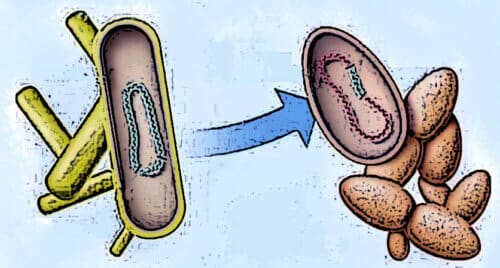Through "evolution in vitro" experiments, Weizmann Institute scientists showed science what happens when bacteria copy genetic information from their neighbors
Imagine a student who came to the test completely unprepared, and can now choose between two dubious courses of action: copy answers from an excellent student who does not speak his language, or copy from a fairly mediocre student who writes in the same language. germs were subjected to a similar test in the laboratory of Prof. Chili pepper In the Department of Molecular Genetics of the Weizmann Institute of Science. The purpose of the test was to find out if they "copy" genetic information from others - and if so, from whom?
Sexual reproduction is the most common way in nature to create new genetic combinations in the population. However, already a few decades ago, scientists discovered that bacteria, which reproduce through asexual reproduction, can create new genetic combinations through "horizontal gene transfer". While in sexual reproduction, also known as vertical transmission, the genes are mixed and passed from parents to their offspring, in horizontal transmission, the DNA is transferred between individuals who are not related to each other and can even belong to another species. "This is somewhat analogous to how languages develop through the acquisition of words from other languages; For example, the way in which words in Arabic and English crept into the Hebrew language," says Prof. Pepper.

If we continue with the language analogy, identifying genes of foreign origin in a certain genome is like trying to find a word that originates in a foreign language among tens of thousands of entries in a dictionary - not an easy challenge at all. The research team, led by Dr. Orna Dehan and research students Shay Slomka de Olivare and Itamar Francoise, faced the challenge using the research approach known as "evolution in a test tube". The experimental setup they planned was quite simple: they grew bacteria Bacillus subtilis in salinity conditions that they are not used to. To the test tube they added DNA from a foreign source to test if the bacteria would copy and integrate it into their genome in an attempt to cope with the salty challenge. For example, DNA samples of archaeons (ancient bacteria) living in the Dead Sea or bacteria from the Mediterranean Sea were put into the test tubes - species that are not relatives of the bacteria in the solution, but are definitely experts in surviving in conditions of high salinity. Another source of DNA put into the test tubes was extracted from relatives of Bacillus subtilis which have only recently adapted to high salinity conditions through evolutionary processes in the laboratory.
The scientists followed the bacterial populations that evolved in test tubes for more than 500 generations and were able to identify events of horizontal transfer. "In one particularly surprising case, up to 2% of the bacterium's genome in the test tube was replaced through horizontal transfer," says Dr. Dehan. However, the scientists discovered that the bacteria "copied" only from bacteria that "speak their language" - i.e. from their relatives (none of them excel at dealing with high salinity), and did not copy at all from the experts for dealing with salinity, since their genome was probably too foreign And unreadable for them. The scientists also saw that the changes that occurred in the genome as a result of the horizontal transfer improved the ability of the bacteria to cope with the salinity challenge compared to their counterparts in the control groups. However, the scientists do not rule out the possibility that at least some of the transferred genes did not contribute to improving the bacteria's ability to survive.
"The price of horizontal transfer is high, as it entails the risk of combining harmful genes. The fact that, despite this, some of the transfers 'survived' throughout the generations in several independent repetitions of the same experiment, suggests that these changes in the genome did give the bacteria an evolutionary advantage", explains Prof. Pepper. "In addition, unlike genetic mutations that occur one after the other, we saw in the experiments a burst of horizontal transfers that occurred simultaneously in certain regions of the genome. These findings indicate that horizontal transfer is a kind of 'shortcut' for evolutionary adaptation."
The research findings may also have an impact on the medical and biotechnology industries in the future. For example, horizontal transfer is the main mechanism for the spread of antibiotic resistance in bacteria. Understanding the process by which genes responsible for resistance to antibiotics are transferred from one species of bacteria to another, may make it possible to deal better with the spread of genes that confer resistance to antibiotics. Also, horizontal transfer can also be used in the biotechnology industry to develop new strains of bacteria for different applications, such as plastic degradation, or for other environmental purposes.
More of the topic in Hayadan:
- Gene transfer between species is much more common than we thought and has accelerated evolution
- It is as if the long neck of the giraffe is transferred to a duck - lateral transfer of genes
- "Lateral transfer of DNA among archaea can indicate a period of rapid evolution"
- Researchers have discovered lateral transfer of genes between blood-sucking insects and mammals
